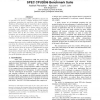Free Online Productivity Tools
i2Speak
i2Symbol
i2OCR
iTex2Img
iWeb2Print
iWeb2Shot
i2Type
iPdf2Split
iPdf2Merge
i2Bopomofo
i2Arabic
i2Style
i2Image
i2PDF
iLatex2Rtf
Sci2ools
110
click to vote
ISCA
2007
IEEE
2007
IEEE
Analysis of redundancy and application balance in the SPEC CPU2006 benchmark suite
The recently released SPEC CPU2006 benchmark suite is expected to be used by computer designers and computer architecture researchers for pre-silicon early design analysis. Partial use of benchmark suites by researchers, due to simulation time constraints, compiler difficulties, or library or system call issues is likely to happen; but a random subset can lead to misleading results. This paper analyzes the SPEC CPU2006 benchmarks using performance counter based experimentation from several state of the art systems, and uses statistical techniques such as principal component analysis and clustering to draw inferences on the similarity of the benchmarks and the redundancy in the suite and arrive at meaningful subsets. The SPEC CPU2006 benchmark suite contains several programs from areas such as artificial intelligence and includes none from the electronic design automation (EDA) application area. Hence there is a concern on the application balance in the suite. An analysis from the pers...
| Added | 03 Jun 2010 |
| Updated | 03 Jun 2010 |
| Type | Conference |
| Year | 2007 |
| Where | ISCA |
| Authors | Aashish Phansalkar, Ajay Joshi, Lizy Kurian John |
Comments (0)

